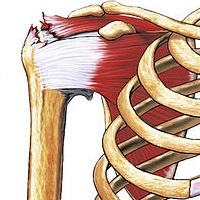
Photo from wikipedia
Patient-related outcome measures are often used for assessing and determining management efficacy of shoulder impingement syndrome (SIS) in overhead athletes. This study was undertaken to examine the psychometric properties (structural… Click to show full abstract
Patient-related outcome measures are often used for assessing and determining management efficacy of shoulder impingement syndrome (SIS) in overhead athletes. This study was undertaken to examine the psychometric properties (structural validity, convergent validity, internal consistency, test-retest reliability, and minimal detectable change) and perform partial confirmatory factor analysis (PCFA) of the Hindi SPADI. Eighty male athletes with a mean age of 21.5 ± 2.20 years were enrolled in the study. Hindi SPADI test-retest reproducibility was calculated by intraclass correlation coefficient (ICC2,1), and Cronbach alpha helped determine internal consistency of the index. Pearson correlation coefficient compared the Hindi SPADI with the Hindi DASH scale to determine convergent validity, while the measurement error was calculated by minimal detectable change (MDC95). Exploratory factor analysis utilized for assessing the structural validity of the index gave a five-factor solution, which explained 70.03% of the variances. The test-retest reliability (ICC2,1), internal consistency, and convergent validity were found to be high, at 0.87, 0.75, and 0.94, respectively. The MDC95was calculated to be 14.20. Additionally, the PCFA confirmed the five-factor solution with fit indices. This Hindi version of SPADI demonstrated satisfactory psychometric properties in overhead athletes with shoulder impingement syndrome.
Journal Title: International Journal of Athletic Therapy and Training
Year Published: 2018
Link to full text (if available)
Share on Social Media: Sign Up to like & get
recommendations!